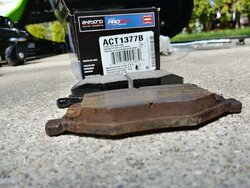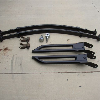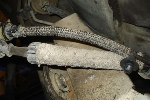Just to bump this up, I found something interesting in my rear brakes this weekend.
My wife has been driving my Sport for the last 5 months and last week she said the brakes were squeaking last week.
I replaced the rear pads/rotors around 70k miles and it's now approaching 100k, so about 30k miles on them.
I was a bit worried the pads were going to be toast, but they still looked fine.
I knew about this thread and the corrosion buildup, so that's what I planned to tackle along with re-greasing the caliper pins.
Passenger side went fine. Cleaned the corrosion behind the clips in the bracket. The caliper pins felt smooth before and after I re-greased them. Pads were now sliding smoothly in the clips again.
Driver's side was a little different. One of the caliper pins was not sliding at all. I could spin it, but it would not slide out. I grabbed a pliers and pulled (with a lot of force) and eventually (slowly) got the pin to come out. One pin in each caliper bracket has a small rubber bushing on the shaft that I think is there for noise (just a guess). I cleaned everything, re-greased and still could not get that pin back in. I tried the other pin and no issues in either position. I could also install the pin without the bushing.
Well, that bushing on the driver's side seemed to be slightly swelled on one end. It wasn't much, but just enough to cause excessive interference. I thought about assembling it together without that bushing, but figured that wasn't a good idea. I was concerned that it would be a part only from dealership (and being a Sunday, they are closed), but luckily my auto parts store had a kit with the rubber boots as well as the bushing for $5. They also had replacement pins for about $15, but the pictures didn't show the bushing, so I was worried I'd still be missing that part.
I brought the bracket and pin with me to check fit before I left the store and sure enough, the new bushing fit and slid in without issue.
Here's the kit I bought. The picture is bad, but it's the 2 smaller bushings that are on the pins. I only replaced the bushing on the driver's side since the other side with fine and already back together.
https://www.autozone.com/brakes-and...t-rear/duralast-pin-boot-kit-16207/690709_0_0
And for reference, here's the caliper pins, which you can see one of the pins has a step down near the end where the bushing goes.
https://www.autozone.com/brakes-and-traction-control/brake-caliper-bolt-guide-pin-rear
Now, I'm not sure why that bushing was swelled up, but I guess fingers crossed it doesn't do it again.
Maybe it was the lube I used last time (I don't remember what I used). The old lube was still present and not dried up, so not sure what happened. This time I used the Sil-Glyde silicone brake lubricant.
Anyway, thanks for reading and hopefully this helps someone if the run into this in the future.











